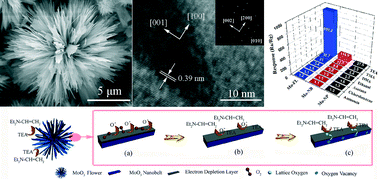An ultraselective and ultrasensitive TEA sensor based on α-MoO3 hierarchical nanostructures and the sensing mechanism†
Abstract
Flower-like, hierarchically nanostructured α-MoO3 was successfully synthesized via a one-step, template-free solvothermal route. Morphological characterization demonstrated that the nanostructures were hierarchically assembled by overlapping single-crystalline nanobelts with exposed (010) facets. These nanobelts, with a width of 40–60 nm and a thickness of 20–30 nm, grew radially from the core of the α-MoO3 flower. The growth mechanism of the α-MoO3 flower was speculated to be through oriented self-attachment of the nanobelts. The gas sensor based on α-MoO3 flowers showed an excellent sensing performance towards triethylamine (TEA) in terms of a high response (931.2) and excellent selectivity towards 10 ppm TEA. Especially, the detection limit was down to 0.001 ppm at a working temperature of 170 °C. The surface status of the α-MoO3 flowers before and after exposure to TEA at 170 °C was investigated by XPS. The probable oxidization product of TEA was analyzed by GC-MS. The MoO3 sensing mechanism could be interpreted as the transformation of triethylamine to vinylamine through two catalytic oxidation processes: the reactions with chemisorbed oxygen, and with lattice oxygen. The possibility relating to an enhanced gas sensing response of the three-dimensional (3D) flower-like α-MoO3 was discussed.


 Please wait while we load your content...
Please wait while we load your content...